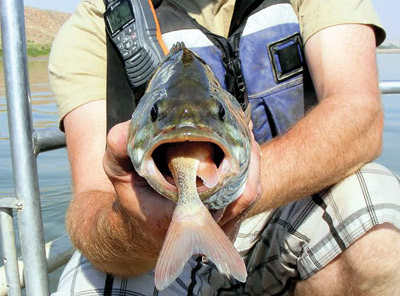Difference between revisions of "Nonnative Invasive Aquatic Species"
Cellsworth (Talk | contribs) |
Cellsworth (Talk | contribs) |
||
| Line 37: | Line 37: | ||
mechanical predator removal. Under the preferred alternative, mechanical | mechanical predator removal. Under the preferred alternative, mechanical | ||
removal of nonnative rainbow and brown trout (and other nonnative predators) | removal of nonnative rainbow and brown trout (and other nonnative predators) | ||
| − | would be implemented through a triggered, tiered approach (see [http://ltempeis.anl.gov/documents/final-eis/vol3/Appendix_O-Biological_Assessment.pdf Appendix D in | + | would be implemented through a triggered, tiered approach (see [http://ltempeis.anl.gov/documents/final-eis/vol3/Appendix_O-Biological_Assessment.pdf Appendix D in BA]) near the confluence of the Little Colorado River and the Colorado River if |
| − | BA]) near the confluence of the Little Colorado River and the Colorado River if | + | |
conservation actions designed to reverse declines in the Little Colorado River | conservation actions designed to reverse declines in the Little Colorado River | ||
humpback chub aggregation were ineffective. Two different tiers of population | humpback chub aggregation were ineffective. Two different tiers of population | ||
Revision as of 14:09, 1 March 2017
|
|
Nonnative Invasive Aquatic SpeciesNon-native fish species present in Grand Canyon were mostly established as a result of intentional stocking to develop sport fisheries in the Colorado River and its tributaries during the late 1800s and early 1900s. Impacts of these actions was not fully understood until later in the 20th Century when a shift to native species conservation management occurred in the NPS. Negative impacts of non-native fish and altered habitats on native fish species has been well-documented throughout the world. Over 20 non-native fish species have been documented in GCNP; However, the more common, large-bodied, species of management concern include rainbow and brown trout, common carp, channel catfish, and bullhead species, striped and smallmouth bass. These species are known predators on native fish or native fish eggs or compete with native fish species. (NPS CFMP-EA_Pg 62) (17 warmwater species, 2 coldwater species, and 1 coolwater species)--- At least 7 additional species occur in nearby or adjoining waters with potential access to the Glen Canyon Ecosystem. LTEMP Experimental Action: Aquatic Resource-Related Experimental Treatments (BA, pages 30-41) [1]Nonnative fish control actions would be implemented if the Little Colorado River humpback chub population declined and proactive conservation actions failed to reverse declining populations [2]. Mechanical removal of nonnative species is a controversial issue in the Colorado River through Glen and Grand Canyons. A spring 2015 meeting of Grand Canyon biologists (NPS, FWS, AGFD, GCMRC) to assess current trout removal triggers resulted in a concept of early conservation measure intervention to maximize conservation benefit to humpback chub and minimize the likelihood of mechanical predator removal. Under the preferred alternative, mechanical removal of nonnative rainbow and brown trout (and other nonnative predators) would be implemented through a triggered, tiered approach (see Appendix D in BA) near the confluence of the Little Colorado River and the Colorado River if conservation actions designed to reverse declines in the Little Colorado River humpback chub aggregation were ineffective. Two different tiers of population metrics would be used to trigger responses such as actions to increase growth and survival of humpback chub (Conservation Actions, Tier 1), or mechanical nonnative fish control (Tier 2), which would only be implemented when Tier 1 conservation actions (actions would focus on increasing growth, survival and distribution of chub in the Little Colorado River and LCR mainstem aggregation area) fail to slow or reverse the decline in the humpback chub population (see Appendix D in BA, Young et al. 2015). In addition, if humpback chub decline and the identified actions are not working, the FWS, in coordination with action agencies and traditionally associated Tribes, will identify future appropriate actions (among other caveats specified in Young et al. 2015). |
| Online training |
Fish Species of the Colorado River in Lower Glen Canyon and Grand Canyon |
Fish photos, information, and maps |
|---|
Potential Threats:
|
|
